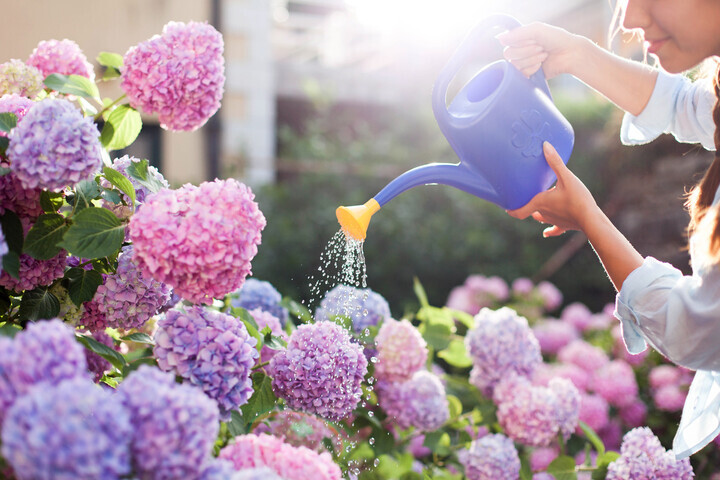From watering tips to pruning advice, a gardening expert shares her insight.
Nothing ruins a garden filled with beautiful hydrangeas faster than a drought. "Any time a plant doesn't receive adequate water, you are putting it through a significant amount of stress," explains Cecilia de Corral, the Director of Design/Build at Brooklyn Grange Rooftop Farms. "If it's a brief period of drought, that stress will present itself as drooping leaves and blooms, yet still retaining their green color. If it's a significant drought, then those wilted leaves will become crisp and eventually drop."

Luckily, de Corral says there are ways to guarantee that your hydrangeas get enough water before this becomes a problem. "The goal with any good watering practice is to know when your garden needs water before the plants signal it," she explains. "Plants thrive with consistent watering, so if you can, invest in a simple battery powered timer to help ensure that waterings are on a schedule. Alternatively, a soaker hose around the base of the plant will ensure water is going directly to where it's needed." Worried your hydrangeas won't recover from a drought period? We asked de Corral for tips on how to get them to bounce back—and here's what she had to share.
Water them for longer.
If you notice that your hydrangeas are starting to look stressed, de Corral says to try and shift your watering schedule to less frequent one, but with longer intervals. "Keep in mind that light surface watering may help the foliage bounce back, but if the plant has experienced significant shock, deep soaks will help the root system rebuild and regain strength," she explains. "Watering them three to four times per week for a full five to 10 minutes is ideal."
Don't get discouraged by dried leaves.
If your hydrangea has foliage that is brown and crisp, don't fret—de Corral says this doesn't mean they're past the point of recovery. "Start your new watering schedule as outlined above, and after a few days you should see new budding appear," she says. "At that point, you can remove any dead blooms and growth by pruning back to the nearest young buds. This pruning is in part for aesthetics, but also to ensure your plant's energy is directed exclusively to new growth."
Make way for fresh foliage.
As your hydrangeas begin to recover, de Corral recommends gently removing any foliage that may prevent new leaves from pushing out. "You can do this by lightly pulling back crisp leaves that are surrounding the new buds," she explains. "If the dead foliage is resisting, even slightly, leave them in place. You don't want to add undue stress to your hydrangea while it's recovering."
Add a layer of mulch to help retain moisture.
A little mulch can go a long way in reviving your hydrangeas after a drought period. "A two- to three-inch deep top dressing under the canopy of your plant will insulate your hydrangea and prevent moisture loss due to evaporation," de Corral explains. "Organic pine bark mulch or shredded compost are ideal because they'll eventually decompose and amend your soil."
Check your hydrangeas for brittleness.
de Corral says if you attempt to bend a small twig or offshoot of growth on your hydrangeas and it breaks off sharply, revealing a brittle interior, there's a chance that your plant is past the point of no return. "Systematically work your way around the plant checking for brittleness," she says. "If there is any bend at all, particularly in larger branches, simply leave the plant as is and give it some time to recover and put out new growth. If the bulk of the plant is proving to be brittle, then you can assume that it's too far gone. That being said, hydrangeas are very resilient and if you're patient they will surprise and reward you. When in doubt, wait until next season before making any drastic decisions."